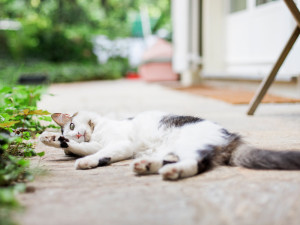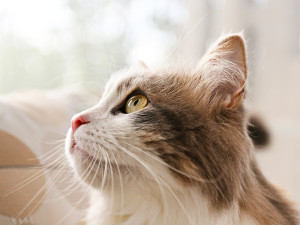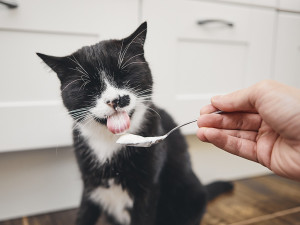Why Does My Cat Have Bald Spots?
It only makes them cuter, but you may need to address the cause for this condition.

share article
In This Article:
Common Causes of Bald Spots on Cats opens in a new tab How to Treat Bald Spots on Catsopens in a new tab
Noticing bald spots on your cat’s fur can be surprising and may indicate an underlying health issue. From pesky parasites to skin allergies, there are several reasons why your feline companion might be experiencing hair loss.
Cats are notoriously uptight about their appearance, and many seem to spend more time on their looks than the average Drag Race contestant. But sometimes their sleek appearance is marred by an unsightly bald spot. Where could that have come from and why is it ruining all of your cat’s hard work?
Common causes of bald spots on cats
Your cat’s commitment to looking great may actually result in bald spots. Many causes of missing hairopens in a new tab in cats are self-inflicted, meaning they are caused by overgrooming. Cat tongues are covered in barb-like structures that help with drinking, eating, and grooming. Those tiny little hooks on the surface of their tongue are why it feels like you’re being scraped with sandpaper when your cat licks something off your finger.
Rough cat tongues are great at removing foreign material or parasites from their coat and leaving fur straight and shiny. They’re also tough on hair if used excessively. The irregular surface of a cat’s tongue can cause hairs to be pulled out or broken as a cat grooms. This isn’t an issue with normal grooming but can lead to bald spots when licking gets excessive. Overgrooming isn’t the only cause of bald spots in cats, but it is the most common one. But what causes a cat to groom too much?
Allergies
Most causes of overgrooming are due to itchiness, and allergies cause a lot of irritation. Allergies can develop to anything a cat comes in contact with, but flea, food, and environmental allergies are some of the most common types. Cats with allergiesopens in a new tab are often generally itchy, though there may be a localized component if they’re dealing with a contact allergy.
Parasites
Many external parasites can affect cats, including:
Fleas
Lice
Chiggers
Ear mites
Sarcoptic mange (scabies)
Demodectic mange
Fur mites
Flies/mosquitoes
In addition to possibly triggering an allergic response to their bites, fleas cause itchiness just by moving around between hairs. Ear mites usually stay in the ears, but they can migrate to the face in cases of severe infestations. They create a lot of irritation, and constant scratching can lead to bald spots on the head and face.
Mange is not as common in cats as it is in dogs, but scabies causes severe itching and is transmissible to humans. Some of these parasites are not easily seen with the naked eye, so don’t assume that your itchy cat is parasite-free just because you don’t see fleas.
Ringworm
Ringworm is a fungusopens in a new tab (not a worm) that causes itchy bald spots. In cats, these bald spots often appear on the head or legs. Ringworm can spread to people and other animals, so be sure to get any suspicious bald spots checked out by your veterinarian.
Other infections
Other skin infectionsopens in a new tab can cause hair loss, discharge, and an increase in grooming. Cats can develop abscesses beneath their skin that cause swelling, thinning of the skin, and hair loss. Abscesses most commonly develop after cat fights. Superficial infectionsopens in a new tab by bacteria, yeast, or fungi can result in bald spots as well.
Medical conditions
Bald spots can also show up without any help from a cat’s tongue. Medical problems like hyperthyroidism (especially in older cats), cutaneous lymphoma, and certain malignant cancers (especially pancreatic cancer) can affect a cat’s hair.
Cats with these problems may have bald spots appear overnight, and hair that can easily be removed in clumps. Cats with bladder stones or bladder inflammation will often overgroom their bellies over their bladder, likely due to pain in the area.
Stress or anxiety
Some cats are worriers, and overgrooming can be a sign of stress or anxiety. While some cats may overgroom temporarily during a stressful time, some develop a behavior disorder called psychogenic alopecia. This disorder is not common, but it is a compulsive disorder that results in bald spots due to excessive licking, even when a stressor is not evident.
Hair growth problems
Cats can also develop bald spots due to a pause in the hair growth cycle. This is uncommon but can occur as a result of severe stress. It may be hard to relate this to a specific event though because the hair may take days to months to fall out and fail to regrow. Exposure to certain medications (like chemotherapy agents) or topical substances (like diesel) can also cause hair to fall out.
How to know if your cat is grooming too much
All cats have different grooming habits. Some love nothing more than to plop down in the middle of a crowd and smack loudly on what most people would consider a private part of their body. Others prefer their privacy and only groom when they’re feeling safe and out-of-sight. Both types of cats can still groom excessively, but it may not always be obvious.
Cats that are grooming excessively (called barbering) may show some of the following signs:
Vomiting, often with hair in it
Constipation or straining to defecate
Hair in their feces
Stubble (prickly fur) in overgroomed areas
Increased grooming frequency
Excessive licking at one area
Biting at skin
Stopping to groom suddenly
Skin redness or irritation
Saliva staining of hair (in lighter-colored cats)
Even if you don’t witness excessive grooming, seeing these symptoms could give you a clue that your cat’s bald spots are self-inflicted. This is valuable information to relay to your veterinarian because the causes for spontaneous hair loss are usually different from the causes for overgrooming.
How to treat bald spots on cats
The process for treating bald spots in cats starts with determining the cause. Because there are so many possible causes for hair loss in cats, pinning down the reason for missing hair is vital to developing an appropriate treatment plan. Your vet can help determine the cause for your cat’s bald spots and work with you to get their full, shiny coat back.
The steps in diagnosing and getting rid of bald spots in cats include:
Physical examination
Your veterinarian will want to perform a thorough examination of your cat to see if any cause for bald spots is evident. This includes checking for visible parasites, examining the skin for changes, and checking for signs of other medical problems that could be triggering hair loss or overgrooming.
Testing
After gathering a history of your cat’s behavior and symptoms and examining your cat, your vet may have a better understanding of which causes are most likely for your cat. Testing can help figure out how to treat bald spots on your cat.
Checking for every possible cause for bald spots would be a lot for your cat to go through, so your veterinarian will most likely start with some basic tests and progress from there. Some common tests for bald spots include:
Skin scraping
Skin cytology
Hair examination
Fungal culture
Blood work and thyroid testing
Urinalysis
Skin biopsy
Skin allergen testing
Cancer screening
Developing tailored treatment plans
Based on the results of testing, your veterinarian can recommend a treatment plan for your cat’s bald spots. There’s no one-size-fits-all solution because there are so many causes for cats to overgroom or lose hair. Some conditions require daily medications to get under control, either for the short or long term.
Some can be resolved with topical therapy with medicated shampoos or ointments only. Others can require treatment of an underlying condition like hyperthyroidism or cancer to fix the problem at its root.
Preventing future bald spots
Cats with external parasites like fleas or mites usually respond wonderfully to monthly preventative medicationopens in a new tab, but all housemates need to be treated for this to be effective. Outdoor cats are more likely to have trouble with repeated infestations because getting the environment under control is impossible for them. Keep in mind, cats who have a flea allergyopens in a new tab can suffer weeks of itchiness from just one flea bite.
Cat parents with kitties who are prone to bouts of overgrooming may benefit from keeping an Elizabethan collar (cone) at home. Cats hate them, but they are great at preventing overgrooming — as long as you get one long enough to be effective. Cones can also help you figure out if a bald spot is due to overgrooming or not.
If the spot is visibly resolving after a couple of weeks with a cone on, it’s probably self-inflicted. Although they can work well at resolving bald spots, cones are not a great long-term solution because no cat wants to live life in a cone, and getting rid of the cause of the itch will make them much happier.
Otherwise, avoiding stressors for your cat is key to prevention. Keep your kitty’s environment calm and pleasant. Invest in some distractions that provide enrichment and make time for interaction daily to keep your cat engaged. You may even find that playing with your catopens in a new tab helps your stress levels as well.
FAQs (People also ask):
Why is my cat getting bald spots?
Bald spots in cats can be caused by a number of problems. Many are due to overgrooming, which can have medical or behavioral causes. But some bald spots are due to hair loss caused by a disease.
Is my cat going bald?
In non-hairless breeds, primary baldnessopens in a new tab is extremely rare. Cats generally lose hair due to an underlying problem. Finding and treating the medical problem at the root of your cat’s hair loss gives a good chance of resolving it.
Why does my cat have dandruff?
Dandruff can be triggered by almost anything that irritates a cat’s skin. Cat dandruffopens in a new tab is commonly associated with the effects on the skin from issues like allergies, parasites, nutritional issues, and endocrine diseases.
References:
A Thin Line: Normal Shedding vs. Feline Alopeciaopens in a new tab
Underlying Medical Conditions in Cats With Presumptive Psychogenic Alopeciaopens in a new tab

Dr. Bartley Harrison, DVM
Dr. Bartley Harrison, DVM is a small animal veterinarian based in North Carolina who has practiced emergency medicine since graduating from the Texas A&M College of Veterinary Medicine. His primary interest areas include pain management, cardiology, and the treatment of shock.
He is a member of the Veterinary Emergency and Critical Care Society, American Veterinary Medical Association, and American Medical Writers Association. In addition to his clinical work, he writes pet health articles to help provide accurate information for both new and experienced pet parents. When he’s not working, he enjoys cooking, traveling, reading, and going on adventures with his dog.
Related articles
![Black and white cat scratching with its paw.]() opens in a new tab
opens in a new tabRingworms in Cats: Symptoms, Treatment, and Prognosis
Well, it’s not a fun thing to deal with, for starters.
![Woman petting her long haired cat on the sofa.]() opens in a new tab
opens in a new tabWhy Does My Cat Have Dandruff? Common Causes and Treatments
Ever heard of “walking dandruff?” Yep, that’s what we said.
![Portrait of siberian cat with green eyes by the window.]() opens in a new tab
opens in a new tabHow to Prevent—or Treat—Cat Ear Infections
How to prevent an ear infection (and treat one if it’s too late).
![cat being offered a treat or vitamin]() opens in a new tab
opens in a new tabThe Best Supplements and Vitamins for Cat Health
Not your mama’s multivitamin.
![A fluffy gray cat playfully swiping at a brown scruffy dog]() opens in a new tab
opens in a new tab5 Ways You’re Low-Key Ruining Your Cat’s Life
Just kidding, but you (or other pets) might be stressing them out more than necessary. Here’s how.
![A cat licking yogurt from a spoon.]() opens in a new tab
opens in a new tab6 Best Cat Probiotics
Is your cat’s microbiome out of whack? It may be time to add probiotics to their diet.









